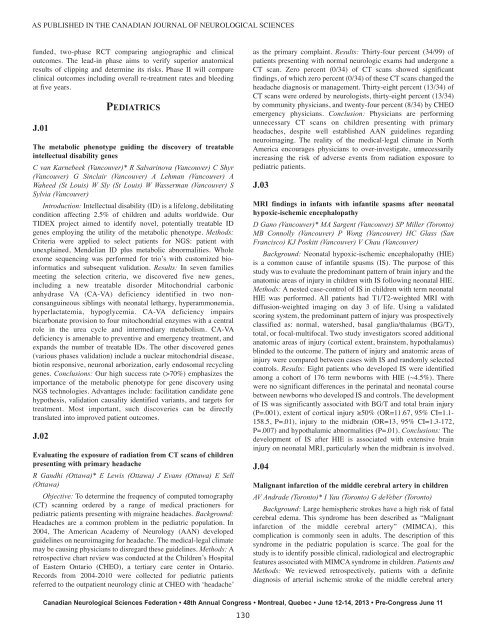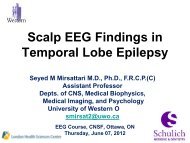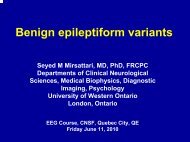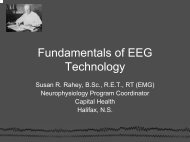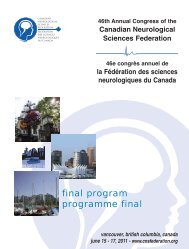Download Program - Canadian Neurological Sciences Federation
Download Program - Canadian Neurological Sciences Federation
Download Program - Canadian Neurological Sciences Federation
Create successful ePaper yourself
Turn your PDF publications into a flip-book with our unique Google optimized e-Paper software.
AS PUBLISHED IN THE CANADIAN JOURNAL OF NEUROLOGICAL SCIENCES<br />
funded, two-phase RCT comparing angiographic and clinical<br />
outcomes. The lead-in phase aims to verify superior anatomical<br />
results of clipping and determine its risks. Phase II will compare<br />
clinical outcomes including overall re-treatment rates and bleeding<br />
at five years.<br />
J.01<br />
PEDIATRICS<br />
The metabolic phenotype guiding the discovery of treatable<br />
intellectual disability genes<br />
C van Karnebeek (Vancouver)* R Salvarinova (Vancouver) C Shyr<br />
(Vancouver) G Sinclair (Vancouver) A Lehman (Vancouver) A<br />
Waheed (St Louis) W Sly (St Louis) W Wasserman (Vancouver) S<br />
Sylvia (Vancouver)<br />
Introduction: Intellectual disability (ID) is a lifelong, debilitating<br />
condition affecting 2.5% of children and adults worldwide. Our<br />
TIDEX project aimed to identify novel, potentially treatable ID<br />
genes employing the utility of the metabolic phenotype. Methods:<br />
Criteria were applied to select patients for NGS: patient with<br />
unexplained, Mendelian ID plus metabolic abnormalities. Whole<br />
exome sequencing was performed for trio’s with customized bioinformatics<br />
and subsequent validation. Results: In seven families<br />
meeting the selection criteria, we discovered five new genes,<br />
including a new treatable disorder Mitochondrial carbonic<br />
anhydrase VA (CA-VA) deficiency identified in two nonconsanguineous<br />
siblings with neonatal lethargy, hyperammonemia,<br />
hyperlactatemia, hypoglycemia. CA-VA deficiency impairs<br />
bicarbonate provision to four mitochondrial enzymes with a central<br />
role in the urea cycle and intermediary metabolism. CA-VA<br />
deficiency is amenable to preventive and emergency treatment, and<br />
expands the number of treatable IDs. The other discovered genes<br />
(various phases validation) include a nuclear mitochondrial disease,<br />
biotin responsive, neuronal arborization, early endosomal recycling<br />
genes. Conclusions: Our high success rate (>70%) emphasizes the<br />
importance of the metabolic phenotype for gene discovery using<br />
NGS technologies. Advantages include: facilitation candidate gene<br />
hypothesis, validation causality identified variants, and targets for<br />
treatment. Most important, such discoveries can be directly<br />
translated into improved patient outcomes.<br />
J.02<br />
Evaluating the exposure of radiation from CT scans of children<br />
presenting with primary headache<br />
R Gandhi (Ottawa)* E Lewis (Ottawa) J Evans (Ottawa) E Sell<br />
(Ottawa)<br />
Objective: To determine the frequency of computed tomography<br />
(CT) scanning ordered by a range of medical practioners for<br />
pediatric patients presenting with migraine headaches. Background:<br />
Headaches are a common problem in the pediatric population. In<br />
2004, The American Academy of Neurology (AAN) developed<br />
guidelines on neuroimaging for headache. The medical-legal climate<br />
may be causing physicians to disregard these guidelines. Methods: A<br />
retrospective chart review was conducted at the Children’s Hospital<br />
of Eastern Ontario (CHEO), a tertiary care center in Ontario.<br />
Records from 2004-2010 were collected for pediatric patients<br />
referred to the outpatient neurology clinic at CHEO with ‘headache’<br />
as the primary complaint. Results: Thirty-four percent (34/99) of<br />
patients presenting with normal neurologic exams had undergone a<br />
CT scan. Zero percent (0/34) of CT scans showed significant<br />
findings, of which zero percent (0/34) of these CT scans changed the<br />
headache diagnosis or management. Thirty-eight percent (13/34) of<br />
CT scans were ordered by neurologists, thirty-eight percent (13/34)<br />
by community physicians, and twenty-four percent (8/34) by CHEO<br />
emergency physicians. Conclusion: Physicians are performing<br />
unnecessary CT scans on children presenting with primary<br />
headaches, despite well established AAN guidelines regarding<br />
neuroimaging. The reality of the medical-legal climate in North<br />
America encourages physicians to over-investigate, unnecessarily<br />
increasing the risk of adverse events from radiation exposure to<br />
pediatric patients.<br />
J.03<br />
MRI findings in infants with infantile spasms after neonatal<br />
hypoxic-ischemic encephalopathy<br />
D Gano (Vancouver)* MA Sargent (Vancouver) SP Miller (Toronto)<br />
MB Connolly (Vancouver) P Wong (Vancouver) HC Glass (San<br />
Francisco) KJ Poskitt (Vancouver) V Chau (Vancouver)<br />
Background: Neonatal hypoxic-ischemic encephalopathy (HIE)<br />
is a common cause of infantile spasms (IS). The purpose of this<br />
study was to evaluate the predominant pattern of brain injury and the<br />
anatomic areas of injury in children with IS following neonatal HIE.<br />
Methods: A nested case-control of IS in children with term neonatal<br />
HIE was performed. All patients had T1/T2-weighted MRI with<br />
diffusion-weighted imaging on day 3 of life. Using a validated<br />
scoring system, the predominant pattern of injury was prospectively<br />
classified as: normal, watershed, basal ganglia/thalamus (BG/T),<br />
total, or focal-multifocal. Two study investigators scored additional<br />
anatomic areas of injury (cortical extent, brainstem, hypothalamus)<br />
blinded to the outcome. The pattern of injury and anatomic areas of<br />
injury were compared between cases with IS and randomly selected<br />
controls. Results: Eight patients who developed IS were identified<br />
among a cohort of 176 term newborns with HIE (~4.5%). There<br />
were no significant differences in the perinatal and neonatal course<br />
between newborns who developed IS and controls. The development<br />
of IS was significantly associated with BG/T and total brain injury<br />
(P=.001), extent of cortical injury ≥50% (OR=11.67, 95% CI=1.1-<br />
158.5, P=.01), injury to the midbrain (OR=13, 95% CI=1.3-172,<br />
P=.007) and hypothalamic abnormalities (P=.01). Conclusions: The<br />
development of IS after HIE is associated with extensive brain<br />
injury on neonatal MRI, particularly when the midbrain is involved.<br />
J.04<br />
Malignant infarction of the middle cerebral artery in children<br />
AV Andrade (Toronto)* I Yau (Toronto) G deVeber (Toronto)<br />
Background: Large hemispheric strokes have a high risk of fatal<br />
cerebral edema. This syndrome has been described as “Malignant<br />
infarction of the middle cerebral artery” (MIMCA), this<br />
complication is commonly seen in adults. The description of this<br />
syndrome in the pediatric population is scarce. The goal for the<br />
study is to identify possible clinical, radiological and electrographic<br />
features associated with MIMCA syndrome in children. Patients and<br />
Methods: We reviewed retrospectively, patients with a definite<br />
diagnosis of arterial ischemic stroke of the middle cerebral artery<br />
<strong>Canadian</strong> <strong>Neurological</strong> <strong>Sciences</strong> <strong>Federation</strong> • 48th Annual Congress • Montreal, Quebec • June 12-14, 2013 • Pre-Congress June 11<br />
130


